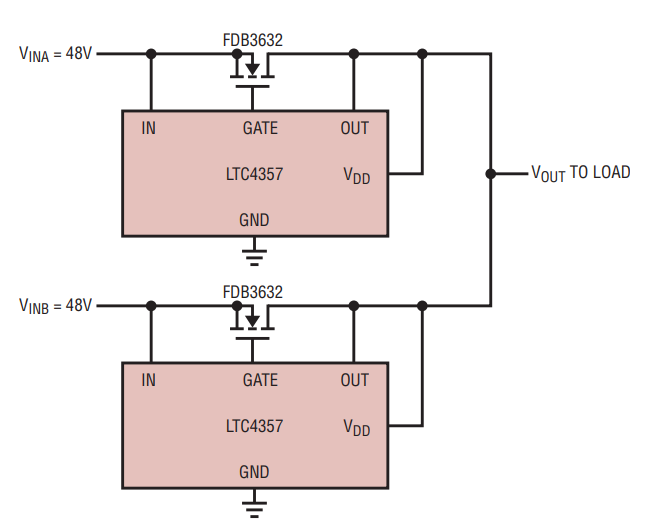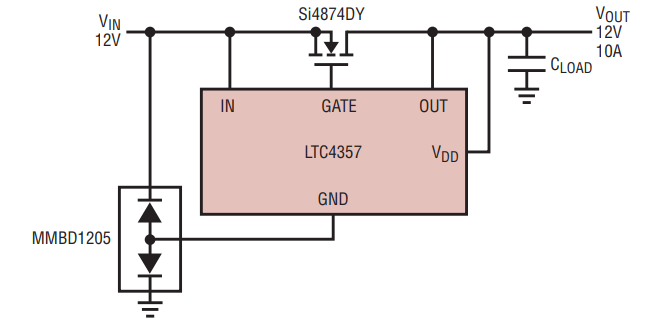9V to 80V Ideal Diode Reduces Heat Dissipation by Order of Magnitude over Schottky
9V to 80V Ideal Diode Reduces Heat Dissipation by Order of Magnitude over Schottky
by
Meilissa Lum
2008-03-01
Introduction
High availability systems often employ parallel-connected power supplies or battery feeds to achieve redundancy and enhance system reliability. Schottky ORing diodes have long been used to connect these supplies at the point of load. Unfortunately, the forward voltage drop of these diodes reduces the available supply voltage and dissipates significant power at high currents. Costly heat sinks and elaborate layouts are needed to keep the Schottky diode cool.
A better solution is to replace the Schottky diode with a MOSFET-based ideal diode. This reduces the voltage drop and power dissipation, thereby reducing the complexity, size and cost of the thermal layout and increasing system efficiency. The LTC4357 is an ideal diode controller that drives an N-channel MOSFET and operates over a voltage range of 9V to 80V.
How It Works
The LTC4357’s basic operation is straightforward. The external MOSFET source is connected to the input supply and acts like the anode of a diode, while the drain is the cathode. When power is first applied, the load current initially flows through the body diode of the MOSFET. The LTC4357 senses the voltage drop and drives the MOSFET on. The LTC4357’s internal amplifier and charge pump try to maintain a 25mV drop across the MOSFET. If the load current causes more than 25mV of voltage drop, the MOSFET is driven fully on, and the forward drop becomes equal to RDS(ON) • ILOAD. If the load current reverses, as may occur during an input short, the LTC4357 responds by quickly pulling the MOSFET gate low in less than 0.5µs.
Load Sharing Redundant Supplies
Figure 1 shows a 48V/10A ideal diode-OR application. An MBR10100 Schottky diode would dissipate 6W under these operating conditions. In contrast, the FDB3632 7.5mΩ MOSFET dissipates only 7.5mΩ • (10A)2 = 0.75W. The reduced power loss increases efficiency and saves space required for heat sinking. If the power supply voltages are nearly equal, the load current is shared between the two supplies. Otherwise, the supply with the highest output voltage provides the load current.

Figure 1. Two load-sharing, redundant, 48V/10A power supplies using an ideal diode.
Load sharing is accomplished using a simple technique known as droop sharing. Load current is first taken from the highest supply output. As this output falls or droops with increased loading, the lower supply begins to contribute. Regulating the forward voltage drop to 25mV ensures smooth load sharing between outputs without oscillation. The degree of sharing is a function of MOSFET RDS(ON), the output impedance of the supplies and their initial output voltages. Backfeeding of one supply into the other is precluded by the diode action of the LTC4357.
Solar Power Application
In solar power systems, Schottky diodes are used to prevent discharge of the battery during hours of darkness. Unfortunately, the voltage drop and power dissipation of a Schottky diode can be quite large when used with high wattage solar panels, thus reducing the amount of power available to charge the battery. Figure 2 uses the LTC4357 with a FDB3632 MOSFET to replace the Schottky diode.

Figure 2. Solar panel charging 12V battery through ideal diode to prevent back feeding.
When the solar panel is illuminated by full sunlight, it charges the battery. A shunt regulator absorbs any excess charging current to prevent overcharging. If the forward current is greater than 25mV/RDS(ON), the MOSFET is fully enhanced and the voltage drop rises according to RDS(ON) • (IBATTERY + ILOAD). In darkness, or in the event of a short circuit across the solar panel or a component failure in the shunt regulator, the output voltage of the solar panel will be less than the battery voltage. In this case, the LTC4357 shuts off the MOSFET, so the battery will not discharge. The current drawn from the battery into the LTC4357’s OUT pin is only 7µA at 12V.
Protecting Against Reverse Inputs
In automotive applications, the LTC4357 inputs can be reversed. An additional component, shown in Figure 3, prevents the MOSFET from turning on and protects the LTC4357. With a reverse input, the diode connected to system ground is reverse biased. The GND pin is pulled by the second diode to within 700mV of the reverse input voltage. Any loading or leakage current tends to hold the output near system ground, biasing the LTC4357 in the blocking condition. If the output is held up at +12V by a backup source or stored charge in the output capacitor, roughly double the input voltage appears across the MOSFET. The MOSFET is off and held in the blocking state.

Figure 3. –12V Reverse input protection blocks reverse input voltage to the load.
Conclusion
The LTC4357 ideal diode controller can replace a Schottky diode in many applications. This simple solution reduces both voltage drop and power dissipation, thereby shrinking the thermal layout and reducing power loss. Its wide 9V to 80V supply operating range and 100V absolute maximum rating accommodate a broad range of input supply voltages and applications, including automotive, telecom and industrial. A dual version, the LTC4355, is available in 4mm × 3mm DFN-14 or SSOP-16 packages.




















